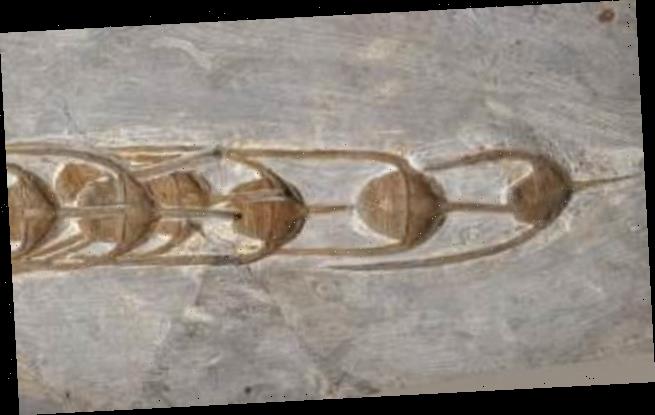The British didn’t invent queuing! Arthropod fossils dating back 500million years show the creatures died in an orderly line ‘while migrating’
- Scientists say that fossils of ancient arthropods discovered in linear formation
- Queuing could be in response to environmental cues or part of reproduction
- There are modern examples of the behaviour in caterpillars, ants, spiny lobsters
Queuing is nothing new reveals a study, showing that primitive early creatures were forming an orderly line 480 million years ago.
Scientists say that the fossils of ancient arthropods discovered in linear formation in Morocco may indicate a ‘collective behaviour’ either in response to environmental cues or as part of seasonal reproductive migration.
Their findings, published in the journal Scientific Reports, suggest that group behaviour comparable to modern animals existed as early as 480 million years ago.
Dr Jean Vannier explained that collective and social behaviour is known to have evolved through natural selection over millions of years.
Ampyx priscus, a trilobite arthropod from the lower Ordovician period. Scientists say that the fossils of ancient arthropods discovered in linear formation in Morocco may indicate a ‘collective behaviour’
He said modern arthropods provide numerous examples, such as the migratory chains of caterpillars, ants or spiny lobsters.
But the origins and early history of collective behaviour has remained largely unknown.
Dr Vannier and his colleagues described several linear clusters of Ampyx priscus, a trilobite arthropod from the lower Ordovician period, in modern day Morocco.
He said: ‘The trilobites, which were between 16 and 22 millimetres long, had a stout spine at the front of their bodies and a pair of very long spines at the back.’
He said that In each cluster of trilobite fossils examined by his team, individuals were arranged in a line, with the front of their bodies facing in the same direction, maintaining contact via their spines.
The research team suggest that, given the scale of the patterns seen, the consistent linearity and directionality is unlikely to be the result of passive transportation or accumulation by currents.
The group is believed to have been fossilised in this linear fashion after dying while travelling and touching spines with each other to form a line
Dr Vannier, of Lyon University in France, said: ‘Instead, it is more likely that Ampyx was killed suddenly while travelling, for example by being buried rapidly by sediment during a storm.’
The researchers suggest that Ampyx probably migrated in groups and used their long projecting spines to maintain a single-row formation by physical contact, as they moved along the seafloor.
Dr Vannier said: ‘This may have been a stress response to disturbance of their environment by storms, detected by motion and touch sensors, which motivated Ampyx to migrate to quieter and deeper waters.
‘A comparable behaviour is seen in present-day spiny lobsters.
‘Alternatively, the pattern may have been the result of a seasonal reproductive behaviour involving the migration of sexually mature individuals to spawning grounds.’
Knowing that Ampyx was blind, the researchers believe that the trilobites may have coordinated using sensory stimulation via spines and chemicals.
Dr Vannier added: ‘The discovery shows that a 480-million-year-old arthropod may have used its neural complexity to develop a temporary collective behaviour.’
WHAT WAS THE ORDOVICIAN PERIOD?
The Ordovician period covers the time on Earth between 485 and 443 million years ago.
During those 45 million years the area north of the tropics was almost entirely ocean.
Most of the world’s land, meanwhile, was part of a southern super-continent called Gondwana.
The Ordovician is best known for its diverse marine invertebrates, including graptolites, trilobites, brachiopods, and the conodonts (early vertebrates).
A typical marine community consisted of these animals, plus red and green algae, primitive fish, cephalopods, corals, crinoids, and gastropods.
More recently, tetrahedral spores that are similar to those of primitive land plants have been found, suggesting that plants invaded the land at this time.
From the Lower to Middle Ordovician, the Earth experienced a milder climate — the weather was warm and the atmosphere contained a lot of moisture.
However, when Gondwana finally settled on the South Pole during the Upper Ordovician, massive glaciers formed, causing shallow seas to drain and sea levels to drop.
This likely caused the mass extinctions that characterize the end of the Ordovician in which 60% of all marine invertebrate genera and 25% of all families went extinct.
The Late Ordovician extinction crisis around 445m years ago saw two major waves of extinction, both caused by climate change associated with the advance and retreat of ice sheets in the southern hemisphere.
This makes it the only major extinction to be linked to global cooling.
Source: Berkley
Source: Read Full Article


